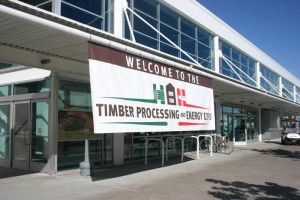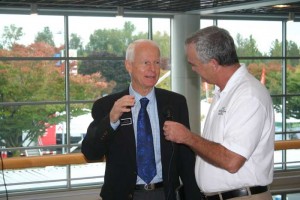The 2014 Timber Processing & Energy Expo reflected an industry in an upgrade mode.
 “This has been the best show we’ve ever been to in the company’s history,” said Joey Nelson, president of Washington-based scanner manufacturer JoeScan.
“This has been the best show we’ve ever been to in the company’s history,” said Joey Nelson, president of Washington-based scanner manufacturer JoeScan.
JoeScan was one of 167 companies to exhibit at the Timber Processing & Energy Expo (TP&EE) held October 15-17, 2014 at the Portland Exposition Center. The event catered to the lumber, veneer/plywood and engineered wood products primary manufacturing industries.
Indeed non-exhibitor registration (mostly mill company and mill operations personnel) increased to 1,700, up tremendously compared to the event two years ago, which was the inaugural TP&EE as produced by Hatton-Brown Expositions and hosted by Timber Processing, Panel World and Wood Bioenergy magazines. In addition, more than 1,000 exhibitor personnel were on hand.
Donnell says the jump in attendance from two years ago makes perfect sense. “We thought it was good attendance in 2012, especially for our first show, and there were some positive signs in the economy then. But certainly the industry has become even more upbeat in the past two years, as evidenced by the tremendous amount of project business that was going on at TP&EE this time.”
The exhibitor hall was a tight sell-out, an adjacent corridor just off the main floor was packed with exhibitors, and several exhibitors set up tents and machinery on the outside lot in front of the hall.
“There was no room to spare,” Donnell adds, noting that exhibitors purchased more than 47,000 sq. ft. of space. “We had a waiting list of probably 30 companies who did not get to exhibit. That’s a good problem to have as they say, but we don’t like the thought of somebody not being able to get in.”
As a result, Donnell says the show organizers are considering moving the exhibit to an adjacent hall at the Portland Expo Center. It would offer a third more space. “Given the waiting list, and also that many exhibitors have indicated they want to increase their space at the next TP&EE in 2016, we certainly have to take a serious look at it.”
Donnell says specific dates haven’t been set for 2016, but the event will be held during the first half of October again.
For JoeScan’s Nelson, the company’s growth in the past year, the introduction of its next generation scanner (JS-25), combined with the overall positive business climate in the industry made for a vibrant TP&EE.
Jesse Vigil, president of Metal Detectors Inc., said it was a very positive feeling on the show floor and they’re looking forward to the coming year. Vigil said they made numerous contacts who were interested in MDI’s top-of-the-line TWA metal detector.
Mike Cloutier, principal at Cut Technologies, said they received tremendous interest in their filing equipment and saws. “The mills are really concentrating on the filing rooms, looking at kerf reduction, and investing in automation to address the labor situation in the filing room. We see some big sales coming forward,” Cloutier said.
Russell Barratt, longtime specialist with Simonds International, said all of their cutting tools plants, knife and saw, are running flat out. Barratt added, however, they are concerned about raw material, noting the dependence on imported raw materials, and potential related problems in the shipping industry and in container ports. “Simonds is working hard to bring new raw materials into the mix,” Barratt said. “We think that’s important not just as a company but as an industry. Our customers need to think about having the cutting tools on hand to run their business.”
Sonia Perrine, senior marketing associate at USNR, praised the abundance of traffic. “The industry is coming alive,” Perrine said. Interest in USNR products at the show’s largest exhibit was huge, such as the ElectraTong lug loader. “We also have some unique mobile interfaces that are revolutionizing the industry, with iPhones and iPads being able to check machine status, activate sorter bins and other activities, which is safer and more convenient,” she said.
Gero Springer, CEO Springer-MiCROTEC, noted the company has opened a sales and service office in Vancouver, British Columbia, which he is directing on-site. “The show has been awesome,” Springer said. “It passed really quickly because the interest was so high in our E-Cut trimmer, CT.LOG scanner and other systems. I think everyone was in a good investing mood and thinking about upgrades and some of them thinking about new mills.”
Sawmill personnel came from throughout the U.S., Canada and overseas, many of them simply taking in the latest technologies, and others who were more specific with their intentions.
John Gunter, maintenance supervisor at Blue North Forest Products, Kamiah, Idaho, commented that they’re working specifically on their sorter and stacker line. But they’re always on the lookout for “more knowledge, more technology, more speed, more recovery. This is the place to be for that.”
Jim Benton, head saw filer at Deer Park Lumber, Tunkhannock, Pa., said they’re upgrading their filing room and in particular looking for a profile grinder for their band saws and Stellite tipping conversions. “It’s one stop shopping here,” he added.
Willy Kalesnikoff, project manager with Kalesnikoff Lumber, Castlegar, BC, “came down to kick some tires, but mainly looking for new innovations and new ideas on saw filing and ways to cut wood.” He pointed to a new heat sensor for planers. “We haven’t seen that before. This is the place to find it.”
Terry Lamers, manager with Lamars Forest, Dallas, Ore., added, “I like the technology here. Some of it is like science fiction. Some people still think that sawmills are old school. They’re completely wrong.”
A frequent topic of conversation was the large number of independent southern pine operations selling to Canadian lumber corporations. Many exhibitors said they hated to see some of the family operations disappear, but they welcomed what they anticipate will be upgrade projects at many of those recently purchased sawmills.
 Also participating was Oregon State Rep. Dennis Richardson, a candidate for governor of Oregon. He spoke the first morning at the plywood manufacturing workshop on critical issues facing the Northwest forest products industry. Afterward he made the rounds on the show floor, and commented, “I understand that timber is to Oregon what corn is to Iowa. It is our legacy.” Richardson said the current government leadership has a policy of continued restraint of utilization of natural resources, while he favors a rational approach with a timber policy that will be good for economics as well as the environment.”
Also participating was Oregon State Rep. Dennis Richardson, a candidate for governor of Oregon. He spoke the first morning at the plywood manufacturing workshop on critical issues facing the Northwest forest products industry. Afterward he made the rounds on the show floor, and commented, “I understand that timber is to Oregon what corn is to Iowa. It is our legacy.” Richardson said the current government leadership has a policy of continued restraint of utilization of natural resources, while he favors a rational approach with a timber policy that will be good for economics as well as the environment.”
Workshops
About 150 people sat in on some of the workshop sessions. The first day featured presentations on technologies and issues in veneer, plywood and engineered lumber manufacturing. The second day featured the Lumber Manufacturing Workshop, in which 25 speakers participated, addressing saw filing and sawing performance, scanning and optimization, and sawmill operations and quality control.
Equipment maintenance and troubleshooting as it relates to lumber quality highlighted a presentation from USNR’s Joe Shields, support technician with more than 40 years of experience troubleshooting electrical and mechanical systems.
The keys to preventive maintenance, Shields emphasized, are understanding life cycles and the need for replacement parts as related to machine performance; regular output measurements to chart performance over a maintenance cycle; and having procedures in place to perform and confirm proper machine alignment.
Shields noted that to optimize performance it’s important to establish baseline measurements for “normal” conditions when the machine is running well, with items such as run times, saw changes, sawing variation, oil and water consumption and air and mechanical pressures. Working with the filing staff to keep track of kerf and kerf reduction as it relates to lumber sizes is also very important, he added.
Shields related a preventive maintenance and troubleshooting approach for managers who find themselves in a familiar position: “Don’t become a referee between the filers, millwrights and operators,” he said. “Instead, put a procedure in place where everyone documents a problem within their area of expertise. Don’t let an electrician say it’s a mechanical problem.”
By minimizing finger-pointing and focusing your personnel on their own inputs and outputs, shortcomings and solutions many times become readily apparent, Shields said.
An interesting presentation from Bryan Beck, senior consultant with The Beck Group, looked at characteristics of top-performing mills.
Beck noted that the top quartile performing operations typically achieve profit margins that are more than double those achieved by the average operation during “good” markets, and these same operations normally continue to stay profitable during poor markets when most operations are experiencing losses.
In the top 25% of mills studied and ranked by EBITA profitability, top-performing mills in the South have a 4:1 advantage over competitors, Beck noted. In the West, the top 25% of mill performers have a 2:1 edge over competitors in profitability, he added.
“Management is the top area of differentiation” in determining profitability and success, Beck said. “Effective leaders have a clear plan and objective, a plan of execution and create teams while building expertise in-house.”
The best managers are always looking to improve and always looking for areas of opportunity within mill operations and machine efficiency, Beck said, noting that effective managers are also good about sharing operating information with employees, especially in areas that the employees have control over.
Terry Brown, director of the Lumber Quality Institute, noted that as a rule of thumb, for every .010 reduction in size, there’s a .6% recovery increase in yield, which makes sawing performance and meeting lumber sizing goals with respect to shrinkage in drying and allowance for planning critical points in lumber manufacturing.
“The nature of log density means lumber shrinkage is widely variable, even within the same log,” Brown said. Real-time QC and lumber measurement systems allow personnel to get much more data on machine performance than with traditional, manual measuring systems, he added.
“The QC guy doesn’t need to measure lumber eight hours a day,” Brown said. “He needs to be freed up to do more analytical work and identify opportunities.”
Andrew Smith, director of Trajectre, spoke about proactive drivers of quality control. He traced the evolution of quality control and noted the introduction of statistical sampling in the 1930s, statistical process control in the 1960s and quality management philosophies in more recent years such as TPM, TQM, 6 Sigma, Lean and TMS. He also followed it in the lumber industry, including real-time size measurement and saw vibration analysis.
Smith defined quality as “a comparison of the output to the desired result,” and quality management as “minimizing or eliminating all waste (time, material, cost) associated with producing the desired result.”
He discussed types of quality issues in sawmills and the implementation of quality metrics, and the importance of employee ownership in the quality control program.
